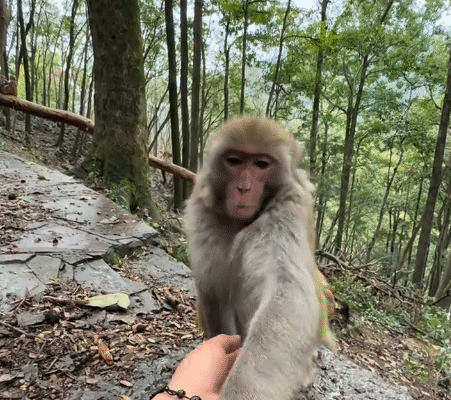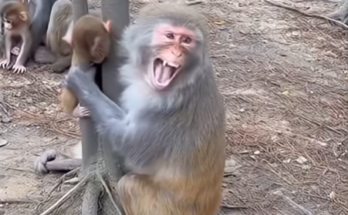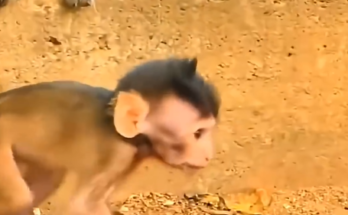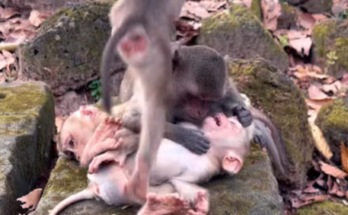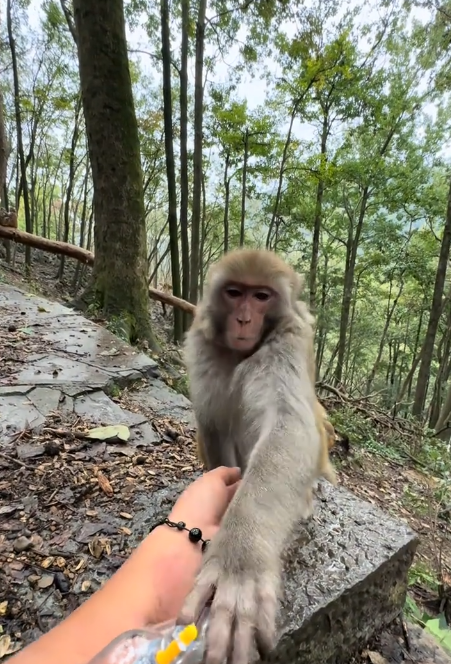
It was another lively afternoon at the park, the kind of day where sunlight poured through the leaves, casting playful shadows on the ground, and families wandered around, laughing and eating snacks. The park was filled with the usual mix of joggers, tourists, and street vendors calling out for attention. But hidden among the trees, a little troop of monkeys was plotting their usual mischief — and at the center of it all was Kenapa, a small monkey whose expressive face and hilarious antics made him the star of the park.
Kenapa wasn’t just any monkey. He had a personality that demanded attention. His big round eyes could express everything from outrage to curiosity to pure mischief in a single glance. Today, however, he was in a particularly stubborn mood. Something had upset him, though no human could quite tell what it was. Perhaps it was the lack of a freshly peeled banana, or maybe it was the humans teasing him by dangling snacks just out of reach. Whatever the reason, Kenapa had decided he would not cooperate — si gamau, as the visitors quickly learned to say with laughter.
The first encounter of the day began with a tourist trying to offer Kenapa a piece of candy. Kenapa glanced at it, tilted his head slightly, and then, with the most exaggerated shrug imaginable, refused. Not only did he refuse, but he also stared at the tourist with an intensity that could be described as both accusatory and comical. His eyes were wide, his lips slightly pursed, and he let out a low, disgruntled chirp as if saying, Kenapa si gamau sambil liatin?!
The tourist, completely confused, held out the candy again. Kenapa did not budge. He leaned back on his perch, crossed his tiny arms, and continued staring, giving the kind of silent protest that left everyone laughing uncontrollably. Children gathered nearby, pointing at him and giggling. “Look! The monkey is mad!” one whispered. “But also… kinda funny!”
This stubborn stare-off didn’t last long before Kenapa decided to escalate his antics. He climbed down to a lower branch, approached the tourist cautiously, and then — just as the human reached for him with the candy — Kenapa darted to the side with a dramatic twist, making the candy nearly fall to the ground. He paused mid-leap, hanging upside down from a branch, staring intently at the human as if to say, You see? I said I’m not taking it!
The crowd erupted into laughter. Someone yelled, “Kenapa si gamau sambil liatin!” and the phrase instantly stuck. Every visitor from that moment on would repeat it whenever Kenapa refused a treat, making the little monkey even more famous for his stubborn, hilarious expressions.

But Kenapa’s antics didn’t stop at simple refusal. He had a flair for drama. At one point, a child tried to lure him with a small piece of chocolate. Kenapa looked at the chocolate, glanced at the child, and then performed the most exaggerated slow-motion shake of the head anyone had ever seen. His eyes widened, arms flailed slightly, and he let out a high-pitched squeak of disapproval. The child shrieked with laughter, and parents around were rolling on the grass, holding their stomachs at the monkey’s absurd reaction.
Other monkeys in the troop noticed Kenapa’s stubborn display and began to mimic him. One younger monkey approached a snack being offered and refused it in exactly the same manner, tilting his head and staring silently at the person holding it. The crowd gasped and laughed even harder — it was like a tiny monkey rebellion of stubbornness had broken out. Kenapa looked on proudly, clearly enjoying the chaos he had caused.
At one point, a vendor carrying a tray of peanuts tried to attract Kenapa with a small handful. Kenapa slowly crawled toward the vendor, eyes fixed on the peanuts, then abruptly stopped, sat down, and crossed his arms, refusing to move any further. He tilted his head and stared at the vendor, his expression a perfect mixture of curiosity and mock indignation. Everyone watching couldn’t stop laughing at how expressive he was. Even the vendor shook their head, amused. “Kenapa si gamau sambil liatin,” they repeated with a smile, now fully aware of the little monkey’s mood.
Kenapa’s favorite stunt was the “pretend interest, then refuse” technique. He would approach a treat cautiously, sniff it, look around at the humans watching, and then, at the last second, perform a dramatic retreat, leaping to a nearby branch with impeccable timing. He would pause there, arms folded, staring back at the humans with the same stubborn glare. The effect was comic gold. Children imitated him, other visitors laughed, and Kenapa basked in the attention, clearly enjoying his role as the park’s tiny comedian.
By mid-afternoon, Kenapa had become a celebrity. Visitors would come specifically to see him, cameras ready, waiting for the exact moment when he would refuse a treat with a dramatic stare. Someone would hold up a candy, the crowd would chant, Kenapa si gamau sambil liatin!, and Kenapa would perform, delivering the perfect combination of refusal, stubbornness, and hilarity.
One particularly memorable moment involved a tourist trying to bribe Kenapa with a small banana. Kenapa glanced at it, then turned away dramatically, pretending to be uninterested. He climbed onto a swing nearby, flopped on it, and stared at the banana from across the distance. Finally, with a deliberate yawn, he sat up, glared at the banana again, and squeaked indignantly. The crowd went wild, laughing and shouting his now-famous catchphrase.
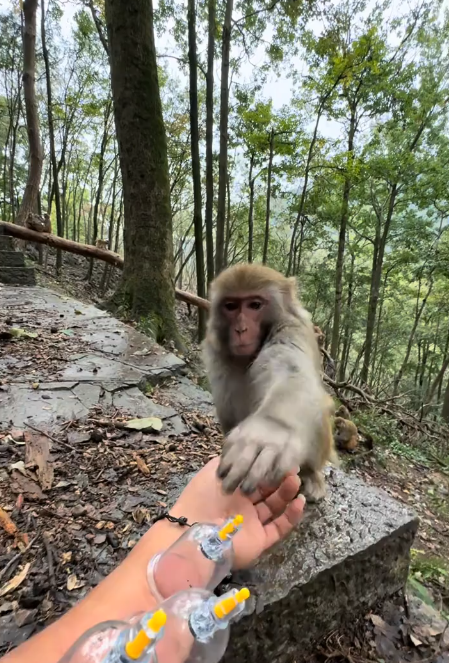
Even the other monkeys seemed impressed. Kenapa had turned simple stubbornness into an art form. His expressions, timing, and gestures were so exaggerated and precise that it was impossible not to laugh at him. By refusing treats in such a theatrical way, Kenapa had turned a simple “I don’t want this” into a performance that entertained everyone in the park.
As the afternoon waned, Kenapa finally accepted a treat — not because he was hungry, but because he wanted to keep the audience entertained. He took it carefully, nibbling while still performing small, exaggerated gestures of mock displeasure, as if to say, See? I am gracious today, but only on my terms! The humans applauded, children cheered, and Kenapa twitched his ears in satisfaction. He had successfully controlled the situation, kept his dignity intact, and ensured everyone had laughed at least ten times at his antics.
By the end of the day, Kenapa had solidified his reputation as the funniest, most stubborn monkey in the park. His phrase — Kenapa si gamau sambil liatin — became a running joke among visitors, and his antics were shared on social media, spreading far beyond the park. Anyone who came to see him knew exactly what to expect: a tiny monkey with big eyes, a dramatic attitude, and a refusal so hilarious it would make everyone laugh until their sides hurt.
As the sun began to set, Kenapa climbed to his favorite branch, looking down at the humans below with a satisfied expression. His small arms were crossed, tail flicking lazily, and eyes twinkling with mischief. He had done it all: refused countless treats, entertained hundreds of people, and earned his place as the park’s tiny comedic superstar.
And somewhere deep in his little monkey brain, Kenapa probably thought: Next time, humans, try harder. You may offer candy, bananas, or anything yummy, but remember — I am Kenapa, and I decide if I want it… sambil liatin!
From that day forward, every visitor who came to the park would eagerly whisper, laugh, and watch: Kenapa si gamau sambil liatin! And every time, Kenapa would deliver, with all the grumpy, funny, and theatrical flair that had made him famous.
